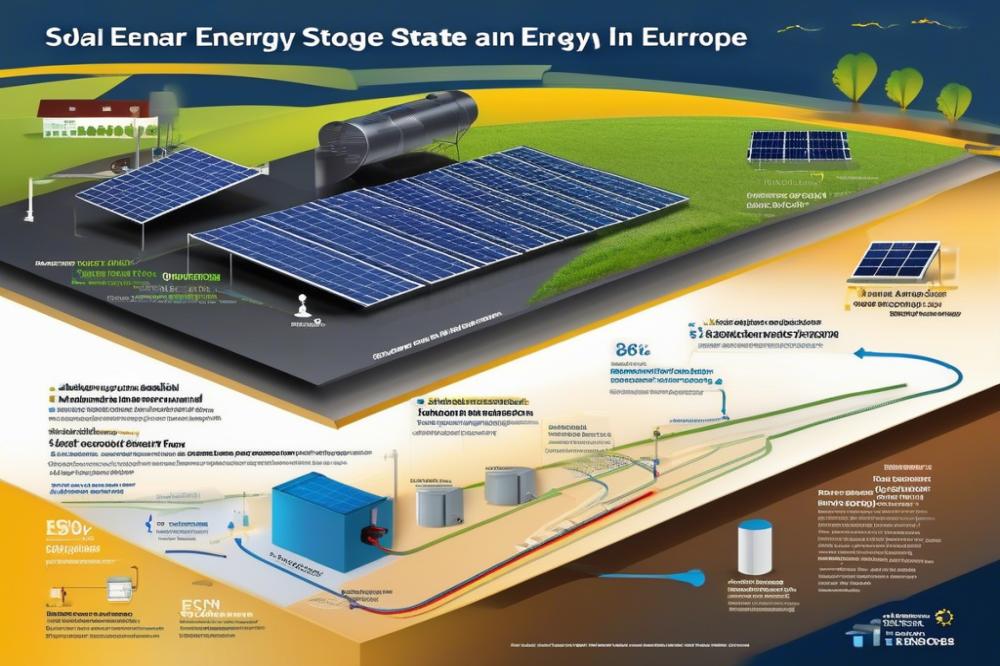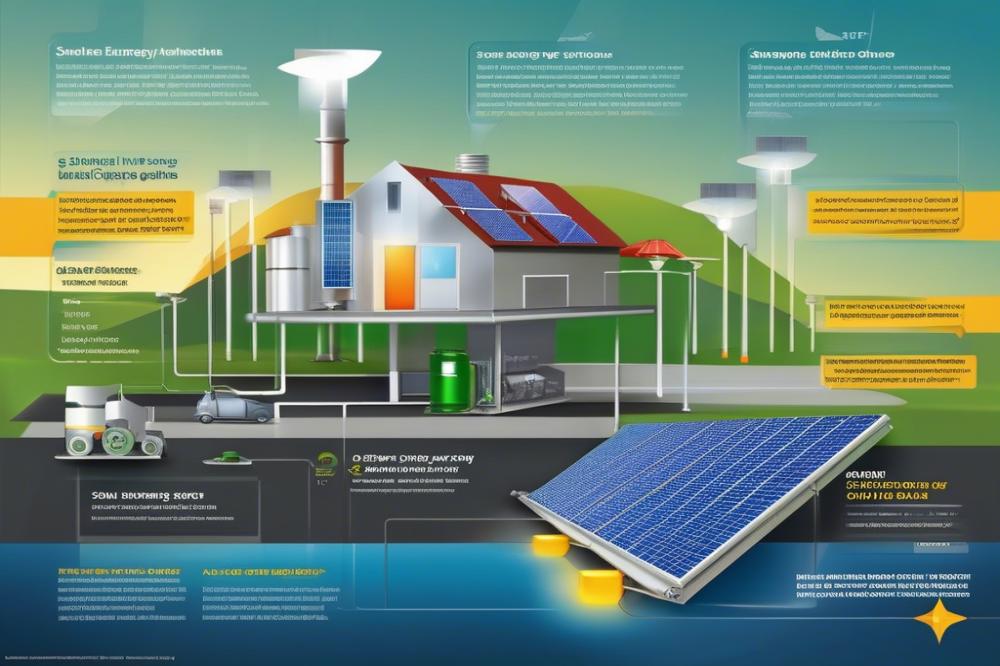Introduction
solar energy storage represents a vital component in the conversation about sustainable energy solutions. As the world shifts towards cleaner alternatives, the significance of effective storage solutions cannot be overstated. These systems play a crucial role in managing the intermittent nature of solar power. By storing excess energy generated during sunny days, they provide a reliable supply when sunlight is scarce.
Importance of batteries in Europe cannot be overlooked. In the renewable energy landscape, solar energy batteries serve as a bridge connecting production and consumption. Their efficiency assists in stabilizing the electrical grid, ensuring that energy demand is met even during peak hours. Without adequate storage options, consumers and businesses would struggle with inconsistent power supply. Thus, energy transition initiatives heavily rely on the advancements in battery technology.
Looking specifically at the European market for solar energy storage, interesting trends are emerging. Many countries are investing in innovative solutions, including lithium-ion, lead-acid, and flow batteries. Key manufacturers are responding to this demand by developing products that cater to diverse needs. The increasing focus on reducing environmental impact further fuels this momentum. As regions prioritize sustainability, they are likely to adopt more advanced energy storage systems. Overall, the European landscape is rapidly evolving, reflecting a strong commitment to renewable energy adoption.
Understanding Solar Energy Storage

Solar energy storage is important for harnessing renewable energy efficiently. It allows users to save energy generated from sunlight for later use. This can be particularly helpful during times when sunlight is not available, such as at night or on cloudy days. The purpose of this technology is to maximize energy usage, reduce reliance on fossil fuels, and support grid stability.
Types of Solar Energy Storage Batteries
Several types of batteries are commonly used in solar setups. lithium-ion batteries are among the most popular options. They offer high energy density, longer life spans, and efficient charging cycles. lead-acid batteries are another choice, known for their lower initial costs. However, they usually have shorter life cycles and require more maintenance. Flow batteries represent a newer technology. They allow for large-scale energy storage and can be cycled more often without degradation.
Comparison of Battery Technologies and Their Application in Europe
Comparing these battery technologies reveals distinct advantages and disadvantages. Lithium-ion batteries dominate the European market trends due to their efficiency and compact size. Key manufacturers continue to innovate, making these batteries more accessible to consumers. Lead-acid options still serve a purpose, especially for off-grid applications. However, their environmental impact raises concerns.
Flow batteries, although less common, offer a unique advantage with scalability. They can store large amounts of energy for longer periods. This makes them particularly suitable for larger solar installations. The energy transition across Europe pushes the need for reliable storage solutions. Industry growth focuses on sustainability and reduced carbon footprints. Battery technology is evolving quickly to meet these demands, benefiting both consumers and the environment.
Best Batteries for Solar Energy Storage in Europe

Several battery technologies dominate the European market today. When looking at options, lithium-ion batteries often come to the forefront. They offer high energy density and efficiency. Most experts agree that these batteries are ideal for storing renewable energy. However, they also come with some drawbacks. High costs and concerns about the environmental impact of mining materials can be significant issues.
Lead-acid batteries are another common choice. They have been used for many years and are known for their reliability. One advantage is their lower price compared to lithium-ion options. However, their efficiency and longevity are not as favorable. They require more maintenance and have a shorter lifespan. Therefore, many homeowners may find them less appealing.
Flow Batteries and Emerging Technologies
Flow batteries are gaining attention for their unique capabilities. These devices can be scaled easily, making them suitable for various applications. One major benefit is their ability to provide grid stability. This technology can last longer than traditional batteries since they use liquid electrolytes. Despite their advantages, the costs remain higher than other types.
Key manufacturers in Europe are focusing on enhancing battery technology. Companies like Siemens, EDF, and Leclanché are leading the way. They are also exploring innovative solutions to meet growing energy demands. The renewable energy sector is evolving rapidly, and these firms strive to stay competitive.
Market availability varies by region and application. Popular choices are influenced by factors such as local energy policies and incentives. Performance metrics like cycle life and charge rates are essential. Buyers should consider efficiency ratings while comparing products. Understanding these specifications will help customers make informed decisions.
European market trends indicate a shift towards sustainable solutions. A greater emphasis is being placed on reducing carbon footprints. Therefore, the energy transition is becoming crucial for both consumers and industries. Understanding battery advantages and disadvantages allows users to select the right technology for their needs.
Key Manufacturers of Solar Energy Storage Systems
Overview of Major Manufacturers in Europe
Many companies are leading the charge in solar energy storage across Europe. These key manufacturers play a crucial role in advancing technology while responding to current market trends. The industry primarily focuses on lithium-ion and lead-acid batteries. Flow batteries are also gaining attention due to their unique advantages. European nations are increasingly investing in energy transition efforts. This shift is essential for achieving grid stability and meeting renewable energy targets.
Profiles of Key Players
One prominent name is Tesla, known for its Powerwall system. This lithium-ion battery has become a household favorite. Another significant player is Sonnen, based in Germany. Their eco-friendly approach appeals to environmentally conscious consumers. Meanwhile, LG Chem continues to innovate with its wide range of energy storage solutions. VARTA and BYD both offer strong alternatives, focusing on affordability and reliability. Each company brings distinct advantages to the European market.
Innovations and Advancements in Battery Technology
Battery technology is evolving at a rapid pace. Manufacturers are continuously working on enhancing efficiency and lifespan. Tesla recently announced improvements that increase energy density. Sonnen’s systems allow users to optimize energy use during peak times, which lowers costs. Flow batteries offer a longer cycle life than traditional options. As technology develops, the use of advanced materials is becoming more common in these systems. Enhanced software solutions are also helping customers manage their energy needs more effectively.
Market Competition and Collaborations
Competition among manufacturers remains intense. Companies are constantly looking for ways to differentiate themselves. Collaborations with technology firms are common, helping to push boundaries in development. Some partnerships aim at combining solar panels with storage solutions for greater efficiency. This trend reflects the need to adapt to evolving European market trends. Moreover, the focus on sustainability is guiding many of these collaborations. Each effort aims to reduce the environmental impact of energy production and consumption.
Regional Trends in Solar Energy Storage
Across Europe, the adoption of solar energy storage varies significantly by region. Countries with strong incentives tend to see rapid growth. For instance, Germany and France have been at the forefront due to supportive government policies.
Government actions play a crucial role in market growth. Financial incentives for homeowners encourage the installation of batteries. Many nations offer subsidies or tax benefits to promote the use of renewable energy and storage technologies. These measures create a competitive edge, driving both local and international investments.
Emerging trends in battery technology are noteworthy. Lithium-ion batteries dominate the market for their efficiency, but alternatives like lead-acid and flow batteries are gaining attention. These technologies offer various advantages depending on the application and energy storage needs. Their unique qualities help diversify choices for consumers and businesses alike.
Looking at the bigger picture, the energy transition is shaping the European landscape. Many countries are pivoting from fossil fuels towards cleaner options. As this shift occurs, solar energy storage is increasingly seen as vital for allowing flexibility in energy supply.
Grid stability is another concern that solar energy storage addresses directly. Fluctuations in energy production can create challenges. Storage solutions help mitigate these issues by storing excess energy generated during peak sunlight hours. This ability dampens the impact of demand spikes on the grid, supporting overall reliability.
Local trends also highlight the need to consider the environmental impact of battery production and disposal. As demand for batteries grows, so does the scrutiny on how they are manufactured and recycled. Key manufacturers must prioritize sustainable practices to meet both market needs and environmental standards.
Each of these aspects paints a broader picture. The interplay between government policies, advancements in battery technology, and the focus on grid stability defines the current state of the European market. Observing these regional trends offers valuable insights into the future of energy storage in Europe.
Environmental Impact of Solar Energy Storage
The growing use of battery technology in energy storage comes with both benefits and challenges. Different types of batteries present varied ecological footprints. The most common choices are lithium-ion, lead-acid, and flow batteries. Lithium-ion batteries are widely favored for their efficiency and energy density. However, their production involves mining minerals like lithium and cobalt, which can harm local environments. Lead-acid batteries, while cheaper, contain toxic substances that pose disposal problems.
Sustainability plays a crucial role in battery production and end-of-life processes. Many key manufacturers are now exploring methods to recycle battery materials. Recycling can reduce the need for raw materials and lessen waste. Flow batteries offer a unique advantage due to their longer lifespan and lower toxicity. These features may lead to reduced environmental impact over time. They are especially appealing for large-scale storage applications in the European market.
The transition to renewable energy hinges on effective storage solutions. Properly designed systems enhance grid stability, allowing for reliable electricity supply even during low sunlight periods. Integrating solar energy storage systems into the existing infrastructure supports a more sustainable energy transition. Advanced battery technology can also help meet varying energy demands. This capability becomes increasingly important as Europe aims to reduce greenhouse gas emissions.
Environmental assessments of battery technologies reveal both opportunities and issues. Striking a balance between energy needs and ecological protection requires careful consideration. Researchers are investigating ways to minimize the environmental impact associated with battery manufacturing. Sustainable practices in sourcing materials can make a significant difference. As the European market trends continue to evolve, prioritizing sustainable solutions is essential.
Final Insights on Solar Storage and Its Future in Europe
Europe’s journey towards a greener future hinges on effective energy solutions. Storing energy generated from sunlight is crucial for maximizing the use of renewable resources. With intermittent energy supply, having reliable storage methods becomes even more significant. This storage helps balance energy demands and eases reliance on traditional fuel sources.
The landscape for energy storage is set to transform significantly. Improvements in battery technology, such as lithium-ion and lead-acid options, promise increased efficiency and cost-effectiveness. As manufacturers prioritize innovation, better performance is on the horizon. Moreover, countries across Europe show differing trends. Some are investing heavily in large-scale installations, while others promote smaller, decentralized systems.
Looking ahead, regional policies and advancements will likely shape the storage market. As more people recognize the value of green energy, adoption rates are expected to soar. Public awareness and government support play essential roles in achieving these ambitious goals. Collaboration between technology companies and policymakers will drive the industry forward.
In summation, energy storage holds a pivotal position in Europe’s transition to renewable energy. It addresses key challenges, such as energy availability and sustainability. The path towards achieving climate goals is more achievable with advancements in storage solutions. As Europe continues to embrace solar energy, the importance of effective energy storage will only grow. Each development brings the region one step closer to a sustainable future.



